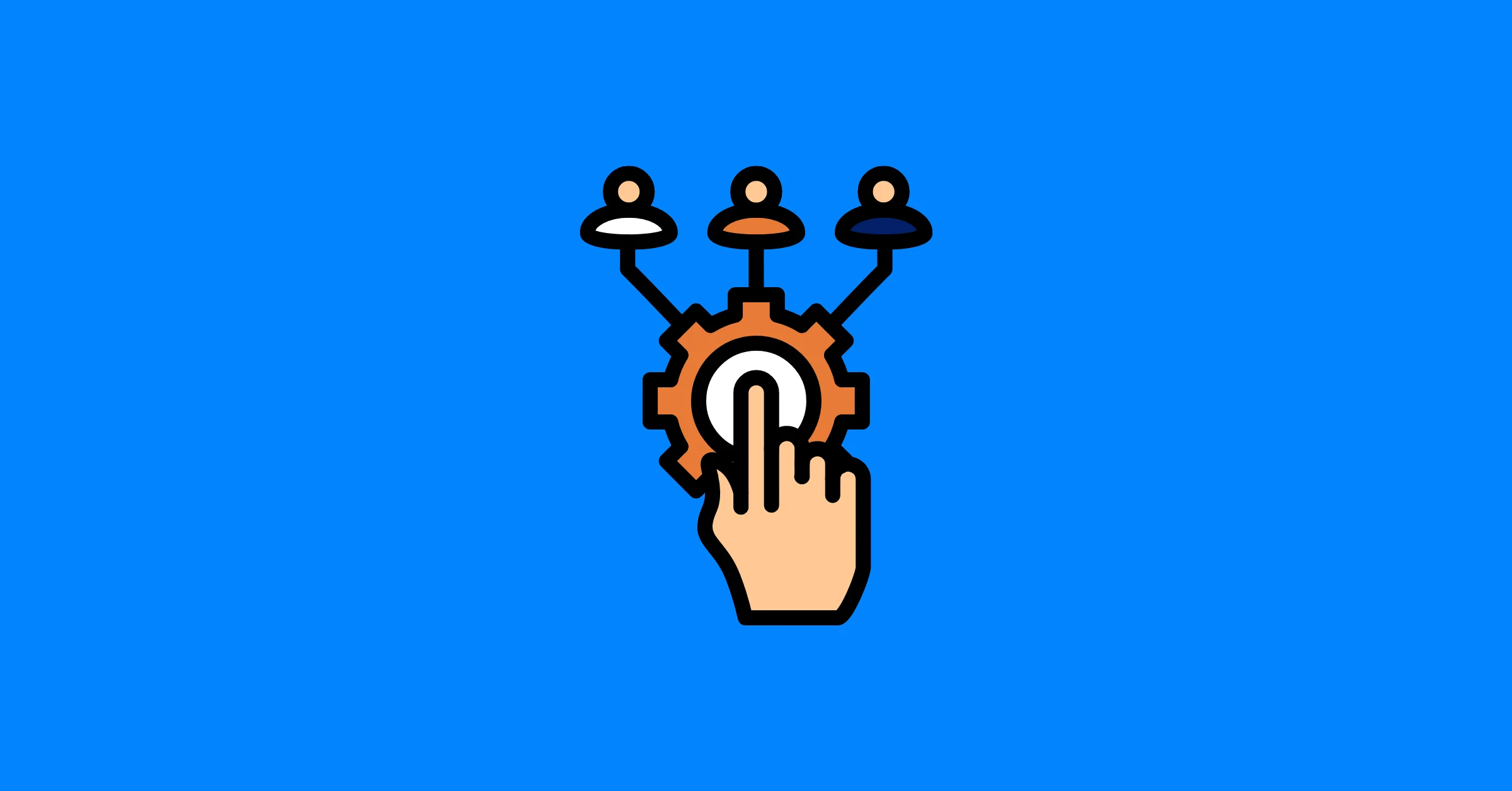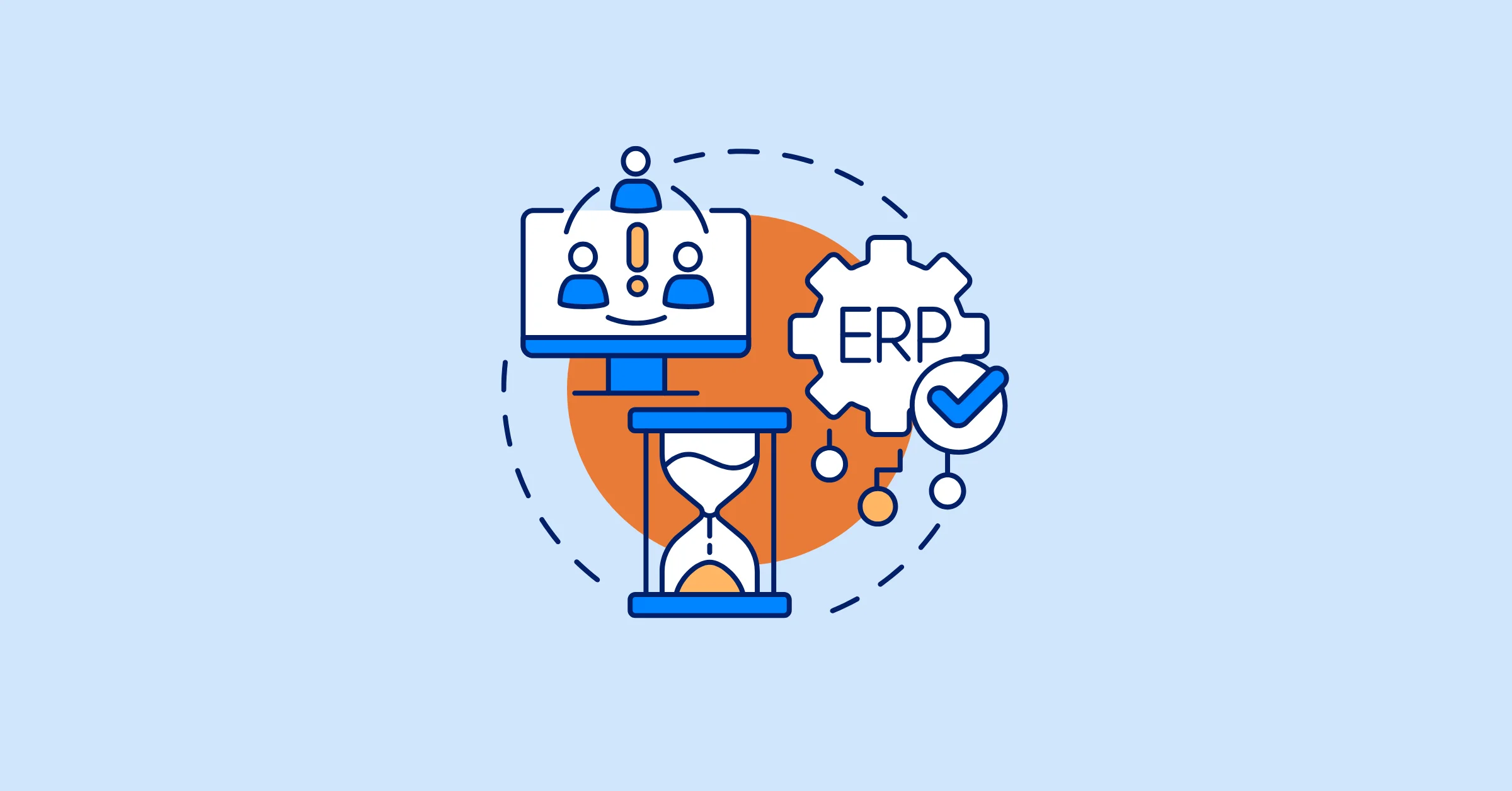What is Resource Planning? Definition, Examples and How to Do it Right
Explore what resource planning is, its essentials, benefits, and proven strategies to optimize team capacity, manage workloads, and ensure project success.
Effective resource planning is the foundation of successful project management. Whether you’re leading a major software development project or coordinating multiple marketing campaigns, organizing your team’s skills, time, and budget in a structured way is crucial to meeting deadlines and staying within budget. But what is resource planning in a practical sense? In this article, we’ll answer that question in detail, explore its core components, and offer best practices to help you optimize resources across any type of project.
Why Does Resource Planning Matter?
Without a solid resource plan, projects can quickly spiral out of control:
- Resource Conflicts: Overbooking key team members leads to missed deadlines and burnout.
- Budget Overruns: Poorly tracked expenditures can balloon costs well above initial estimates.
- Misaligned Skillsets: Incorrectly matching tasks and expertise results in inefficient work and potential rework.
By contrast, resource planning keeps you in control, ensuring each aspect of your project is allocated efficiently. In turn, your team can maintain productivity, morale, and alignment with strategic goals.
What Is Resource Planning?
At its core, what is resource planning? It is a strategic process of identifying, allocating, and managing the resources (human, financial, and material) needed to complete a project successfully. Proper resource planning ensures that the right people and tools are available at the right time and in the right quantities, so projects can advance without unnecessary strain on your budget or team.
Key questions that resource planning aims to answer include:
- What resources are essential for achieving the project’s goals?
- Who is available to contribute, and when can they do so?
- How can we optimize both human and non-human resources for maximum efficiency?
By tackling these questions upfront, you can create a stable project environment where tasks are clearly assigned, costs are under control, and everyone knows their role.
Types of Resources to Consider
To plan resources effectively, you first need to understand what counts as a “resource.” It’s not just employees, it includes every input that affects project execution.
1. Human Resources
- What it covers: Employees, contractors, consultants, specialists.
- Key considerations: Skills, seniority, availability, productivity, and career development.
- Practical approach: Build and maintain a skills inventory — a central record of team members’ expertise, certifications, and capacity. This makes allocation more data-driven and less guesswork.
2. Financial Resources
- What it covers: Budgets, contingency funds, vendor payments, overhead.
- Key considerations: Financial forecasting, cost baselines, and controlling burn rate.
- Framework: Use Earned Value Management (EVM) metrics:
- Planned Value (PV): What you expected to spend by this point.
- Actual Cost (AC): What you actually spent.
- Cost Variance (CV = PV – AC): Shows whether you’re ahead or behind budget.
3. Material Resources
- What it covers: Physical assets such as raw materials, machinery, workspace, and consumables.
- Key considerations: Procurement lead times, storage, and maintenance. Poor planning here leads to project stalls (e.g., waiting weeks for a critical part).
4. Technological Resources
- What it covers: Software, platforms, IT infrastructure, automation tools.
- Key considerations: Access, compatibility, licensing, and scalability.
- Example: A marketing project may need design software, an analytics platform, and cloud storage — all budgeted and available upfront.
5. Time
- What it covers: Availability of resources, deadlines, task durations, dependencies.
- Key considerations: Time is finite and non-renewable. Double-booking or ignoring dependencies leads directly to overruns.
- Technique: Use capacity planning
Effective Capacity = Total Hours Available × 0.7
(The 0.7 factor reflects that employees are rarely 100% productive due to meetings, admin work, etc.)
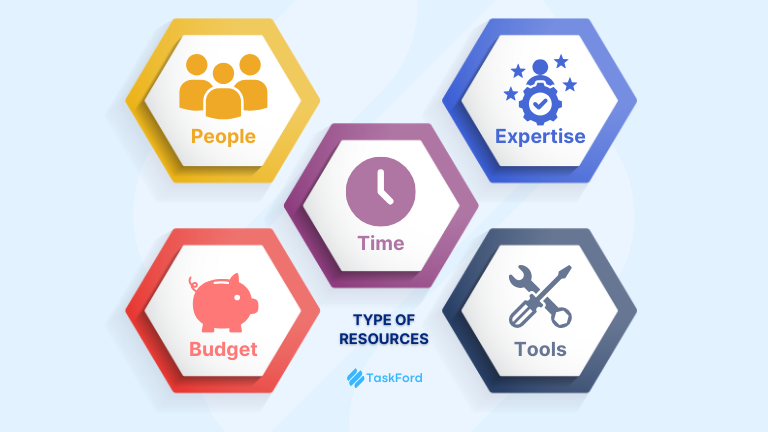
Benefits of Resource Planning and Why Is It Important?
Understanding resource planning is only the beginning. Here’s why it’s indispensable:
- Maximizes Efficiency: Proper resource planning aligns tasks with available capacity, prevents overlap, and ensures your team works productively.
- Prevents Burnout and Boosts Morale: Balanced workloads reduce stress and turnover, keeping your team motivated and engaged.
- Improves Budget Control: Visibility into resource costs helps you avoid overspending and surprises, allowing for proactive adjustments.
- Reduces Project Delays: By aligning schedules with resource availability, tasks can progress without waiting on overbooked team members or missing skill sets.
- Enhances Decision-Making: Real-time insights into resource usage empower you to make data-driven choices around task assignments and project timelines.
- Predicts and Manages Future Demands: Forecasting future resource needs guides hiring, training, or tool investments before bottlenecks occur.
Example: A small manufacturing firm coordinates its production schedule to match material deliveries and worker shifts. This planning prevents idle machinery, reduces overtime costs, and improves on-time order fulfillment—boosting both profit margins and employee satisfaction.
What Happens If You Don’t Manage Your Resources?
Neglecting resource planning can cause a host of problems:
- Overhiring and Underutilization: Hiring without accurate forecasting can lead to idle staff and wasted salaries.
- Burnout and Productivity Loss: Key team members might be continuously overworked while others have no meaningful tasks.
- Budget Overruns: Poor tracking can lead to unexpected costs, especially in staffing or tool licenses.
- Missed Deadlines: Insufficient skills or personnel at key stages cause delivery delays, impacting client satisfaction.
- Lack of Visibility: Without a structured plan, real-time insights into resource usage are minimal, harming decision-making.
Example: The Software Development Scenario Imagine managing a large software project on a tight timeline. What if you don’t plan your resources? * The development team might be overloaded with tasks, risking missed deadlines. * You could exhaust the budget for software licenses too early, leaving no funds for necessary QA tools. * With no QA testers available at the right time, defects remain undetected until late, causing expensive delays.
Core Components of Resource Planning
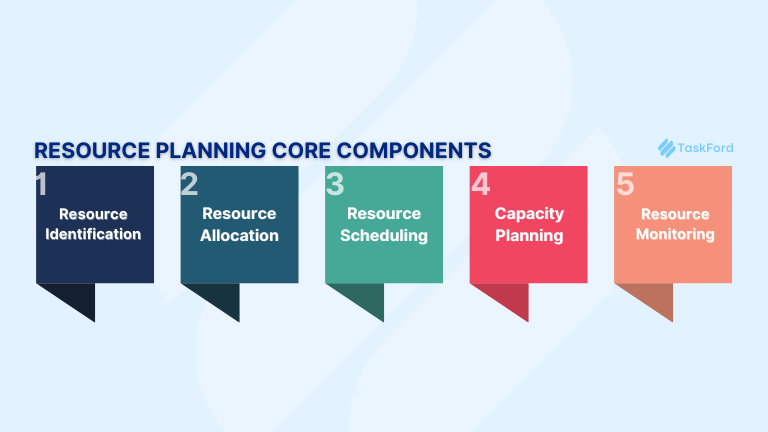
Resource planning relies on five interconnected components. Each one addresses a specific need in managing resources effectively.
1. Resource Forecasting
Definition: Estimating the type, quantity, and timing of resources needed.
How to do it:
- Build a Work Breakdown Structure (WBS): Translate deliverables into tasks and estimate hours required.
- Convert hours into resource demand using availability caps (e.g., 30 billable hours/week per employee).
- Adjust estimates using historical data for accuracy.
Formula:
Required Resources = Total Task Hours ÷ Available Hours per Week per Resource
2. Resource Allocation
Definition: Assigning the right resources to tasks at the right time.
How to do it:
- Match tasks to skills, not just roles.
- Balance workloads across the team.
- Prioritize scarce resources (like senior experts) for tasks where they add the most value.
Trade-off: Assigning senior specialists accelerates timelines but raises costs. Use a decision framework to balance speed vs. budget.
3. Resource Scheduling
Definition: Aligning resource availability with project timelines.
How to do it:
- Map resource demand against availability with calendars or Gantt charts.
- Spot over-allocation (when the same person is booked for multiple high-demand tasks simultaneously).
- Apply resource leveling (adjust deadlines to fit resource availability) or resource smoothing (redistribute tasks without moving deadlines).
(Learn more: Resource Smoothing vs. Resource Leveling: Key Differences Project Managers Should Know)
4. Resource Tracking
Definition: Monitoring actual resource use vs. the plan.
How to do it:
- Track utilization rates weekly.
- Compare planned vs. actual hours with variance analysis.
- Monitor financial burn rates (spend vs. planned budget).
Metric:
Utilization Rate (%) = (Actual Hours Worked ÷ Total Available Hours) × 100
5. Resource Optimization
Definition: Adjusting resource use during the project to maximize efficiency.
How to do it:
- Reallocate idle staff to higher-priority work.
- Cross-train employees to handle multiple roles.
- Bring in contractors for temporary gaps.
Key question: Are resources being used where they create the most value?
Stages of Resource Planning
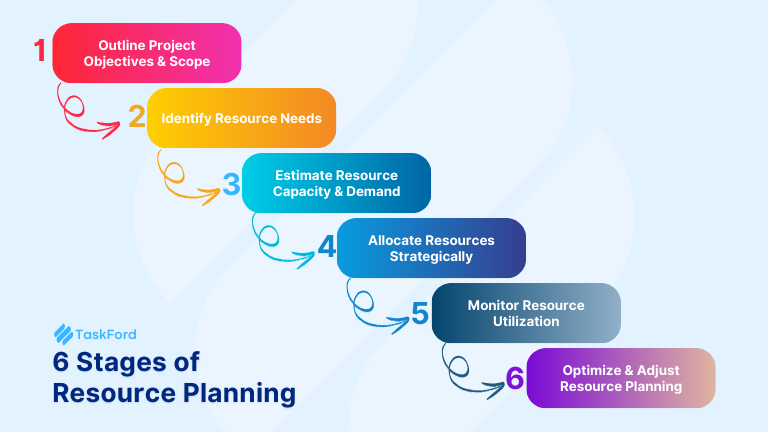
Following a structured process ensures that the right resources are available when they’re needed:
- Outline Project Objectives and Scope: Define deliverables, goals, and success criteria. Clarify constraints around timelines, budgets, and scope.
- Identify Resource Needs: List required skills, manpower, materials, and financial resources for each project phase. Consider both tangible (equipment) and intangible (expertise).
- Estimate Resource Capacity and Demand: Analyze your current resources and how much work they can take on. Forecast any skill gaps or shortages before they become critical.
- Allocate Resources Strategically: Match tasks to individuals with the right skillset and availability. Utilize resource management tools to manage allocations in real-time.
- Monitor Resource Utilization: Track tasks, workloads, and deadlines throughout the project. Adjust as priorities shift or new requirements emerge.
- Optimize and Adjust Resource Planning: Revisit and refine your resource plan as the project progresses. Incorporate team feedback to improve future planning.
Common Mistakes to Avoid When Planning Resources
- Relying on Spreadsheets or Outdated Tools: Manual methods often lead to errors, version-control issues, and limited forecasting.
- Planning Without Full Resource Visibility: Overlooking team members’ skill sets and availability can create major bottlenecks.
- Lack of Forecasting for Upcoming Projects: Delaying resource planning until the last minute can result in a scramble to fill skill gaps.
- Mismanagement of Permanent vs. Contingent Workforce: Too much reliance on full-time staff for short projects can inflate costs; ignoring contractors can cause shortages.
- Assigning Over- or Under-Skilled Resources: Mismatching tasks and expertise slows progress or inflates budgets.
- Unplanned Last-Minute Hiring: This reactive approach often leads to mismatched skill sets and increased costs.
Do You Need Tools to Do Resource Planning?
While it’s possible to practice what is resource planning using spreadsheets and email threads, dedicated resource planning software offers significant advantages:
- Real-Time Visibility: Centralized dashboards and scheduling boards show every team member’s capacity and assignments.
- Automated Resource Allocation: Tools can automatically match tasks to individuals based on skill, availability, and workload.
- Error Reduction: Minimizing manual data entry lowers the risk of spreadsheet errors.
- Improved Collaboration: Shared calendars, notifications, and version control keep everyone updated.
- Scalability: As your projects or team grows, software can handle increased complexity without losing clarity.
Example: The E-commerce Pitfall Imagine running multiple promotions using only spreadsheets and email threads. * Updates vanish in endless email chains, causing double work. * Conflicting spreadsheet versions lead to missed deadlines. * No central dashboard leaves teams guessing who’s free or overloaded. * Operational inefficiency skyrockets, hurting both profits and morale.
Key Features to Look for in a Resource Planning Tool
If you’re serious about resource management and doing it effectively, choose a platform that offers:
- Advanced Roadmap: Provide a high-level view of projects and resource alignment with long-term goals.
- Project Management: Visual timelines for tasks, milestones, and dependencies, making scheduling simpler.
- Comprehensive Resource Allocation: Ability to assign tasks based on skill sets and availability while identifying conflicts early.
- Resource Dashboards: A centralized hub for monitoring real-time workload distribution, preventing over-utilization or downtime.
- Real-Time Collaboration: Automated updates and notifications to keep everyone on the same page, even when tasks shift.
- Time Tracking & Cost Management: Integration for logging billable hours, tracking expenses, and ensuring you stay within budget.
- Custom Dashboards and Reports: Generate insights on team performance, resource usage, and progress to make data-driven decisions.
Price Over Value A design agency picks the cheapest project management tool available.
* Missing features demand pricey add-ons, raising overall costs. * Limited integrations force manual data transfers, slowing daily work. * The system can’t scale, creating bottlenecks in growing projects. * Ultimately, the “bargain” tool proves more expensive in time and productivity.
Resource Planning with TaskFord
While frameworks and best practices are essential, they work best when supported by the right system.
TaskFord is a comprehensive project management and resource planning platform that helps teams plan, allocate, and track resources with clarity. Its resource planning feature gives managers real-time visibility into team capacity, workloads, and availability, making it easier to prevent over-allocation and ensure projects stay on track.
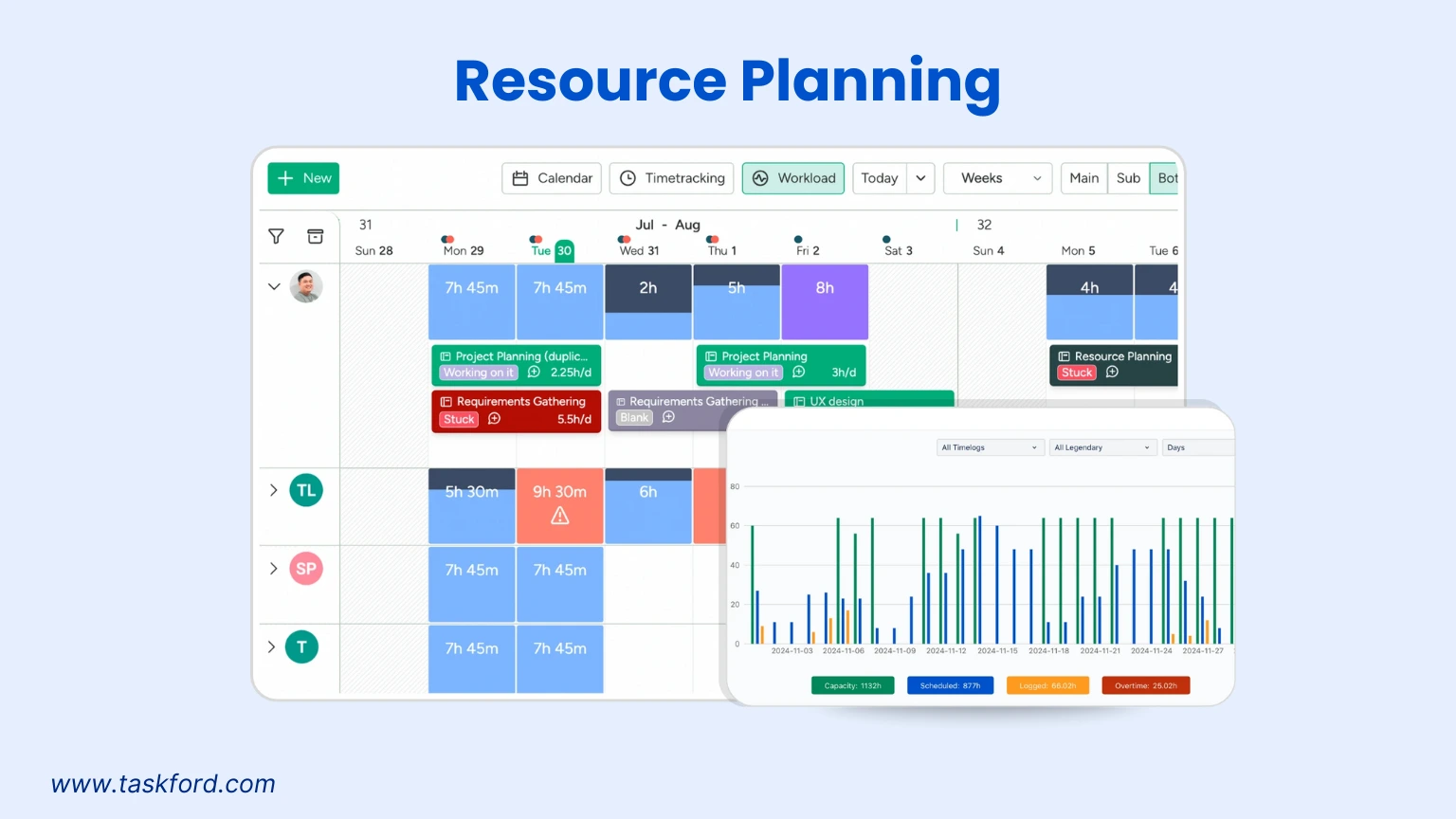
By connecting resource data with project timelines, TaskFord turns resource planning into an ongoing process rather than a one-time exercise, helping organizations make smarter decisions and adapt quickly as priorities shift. Its robust features make it different from other tools like Wrike.
Conclusion
What is resource planning? In essence, it’s a proactive strategy that ensures you have the right people, skills, and budgets in place to complete projects on time and within cost. By following a structured process, including identifying, allocating, scheduling, and monitoring resources, you can avoid common pitfalls like missed deadlines, team burnout, and budget overruns.
Well-implemented resource planning provides balanced workloads, clearer accountability, and smoother project delivery. Whether you manage complex engineering tasks or cross-functional marketing initiatives, dedicating time and tools to this essential discipline will help you drive better results, keep team morale high, and adapt quickly to changing demands. Embrace resource planning to unleash your team’s full potential and achieve consistent project success.
Making work simpler,
smarter, and more connected
Join our waitlist and be notified first.

Related Blog
Subscribe for Expert Tips
Unlock expert insights and stay ahead with TaskFord. Sign up now to receive valuable tips, strategies, and updates directly in your inbox.

